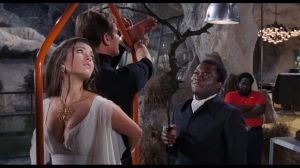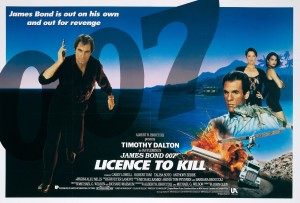One thing you’ll never catch me doing on this blog is using star ratings. It’s not that I don’t believe in them. I just find them a bit too arbitrary for my own taste. Opinions can change so fast that you could give two or three stars to a film that you later realize is an all-time classic. I normally avoid making lists of rankings for similar reasons. Apart from how my own thoughts are subject to change, that’s nothing compared to how different others would think the same list should look. But then that’s kind of the point, isn’t it? The subjectivity of it all?
Besides, when you have a series of films with the kind of history that the James Bond franchise has enjoyed… and the wide range in quality it has experienced over 50+ years… that makes it the perfect candidate for a list such as this. Never having the pleasure of watching the entire series back-to-back before now, it’s been quite a trip through time. There were at least two, possibly three which I’d never seen before. Others I hadn’t seen in a long time. There are those which I almost know by heart and love very much, and some which at times tested my sanity. Through it all, the most unexpected of events took place: The James Bond series has within the space of the last month or so turned into my favorite film franchise! Without any further delay, here they all are, ranked by level of my own personal enjoyment, counting from 24 up to Number 1.
Having Christopher Walken as the main villain ought to make any film enjoyable on some level. Not so much with “A View to a Kill.” Watching Grandpa Bond (58-year old Roger Moore) hop into bed with women young enough to be his daughters is too depressing to think about. The plot doesn’t help matters either. Much of the early portion of “A View to a Kill” has something to do with horse steroids. That’s funny, because the whole thing makes me feel as though I’m on Ambien.
As a matter of fact, I DID have to show off another image of Roger Moore dressed as a freaking clown! It really puts into perspective just how bad “A View to a Kill” is when “Octopussy” can make Bond look this ridiculous and still manage not to be the worst film in the series.
Bad music. Bad CGI. Bad acting. Bad writing. Bad Halle Berry, too. Bad, bad, bad. The only good thing to come out of this frozen turd was that it eventually led to the hiring of Daniel Craig as the next James Bond.
21. Diamonds Are Forever (1971)

Yes, they are forever… and, sadly, so is this halfhearted effort from the guy who used to completely own the role of James Bond. That’s what happens when you do it all for the money. The only actual gem in “Diamonds Are Forever” is Charles Gray, who to this very day is still the best actor ever to play Ernst Stavro Blofeld.
20. The Spy Who Loved Me (1977)

This’ll probably be the one to raise the most eyebrows, seeing as how “The Spy Who Loved Me” is usually well-thought of, and considered by many to be Roger Moore’s best as Bond. Not by me. Moore and Barbara Bach don’t have near the amount of chemistry that their characters require, and the plot is way too familiar… something that’s probably less problematic if you’re watching this one as a stand-alone. I didn’t, so I can’t excuse it.
Stupid, bloody stupid movie. The first 2/3 are hard to watch under any circumstances. Jaws is brought back for a second go-round after “The Spy Who Loved Me,” only now he’s even more of a punchline than ever before. Poor guy belongs in a Road Runner cartoon. The outer space stuff in the last 1/3 is so beyond crazy that I actually end up liking this part of the movie… just because it had the balls to be this silly. Still doesn’t make “Moonraker” a good James Bond film.
18. The Man with the Golden Gun (1974)

Hey! I know what let’s do! Let’s take the two very best things about “The Wicker Man”… Christopher Lee and Britt Ekland… put ’em together again and set them up to fail. We’ll even throw in Tattoo from TV’s “Fantasy Island”! Still not enough? How ’bout we bring back Sheriff J.W. Pepper? You liked him the first time, didn’t you? …Well no, damn it, I didn’t! Ekland ends up looking like a stereotypical dumb blonde. Someone should have done some hard time for writing her that badly. But Christopher Lee is up to the challenge and pretty much carries “The Man with the Golden Gun” all by himself. Almost makes up for the things the movie gets wrong. Almost.
17. Tomorrow Never Dies (1997)

Pierce Brosnan’s second adventure as Bond is actually not half-bad. Certainly got a lot of help from his co-star, Michelle Yeoh. Bond’s cold-blooded murder of Vincent Schiavelli’s Dr. Kaufman is a true moment of fist-pumping satisfaction. But for whatever reason, Jonathan Pryce just isn’t all that threatening as the villain.
One of the only truly disposable Bond films. It’d be further down on the list if it weren’t for Daniel Craig. Also kind of wish we’d gotten more out of Gemma Arterton’s Strawberry Fields (pictured with Craig) before her unfortunate demise.
The only Bond film I had to go back and reassess after compiling this list. The good: some of the most spectacular action scenes of ANY Bond film. The mesmerizing: THAT dress! The so-so: the chemistry between James Bond and Madeline Swann. The not-so good: Bond and Blofeld’s familial connection, and the notion that Blofeld and SPECTRE were behind the plots of each of the first three Daniel Craig films. Still, all in all a damn good movie which I intend to see again sooner rather than later.
14. You Only Live Twice (1967)

So much build-up leads to such a crushing disappointment. Ernst Stavro Blofeld had existed only in the shadows for several of the preceding films, and all but the final twenty minutes of this one. “You Only Live Twice,” although it would never have been considered perfect, was pretty good right up until the reveal of Donald Pleasence (whom I otherwise love). Gone is the menace, replaced by a laughably defeatable wimp who can’t fire a kill shot at Bond when he has the chance to take it. Not that I’d actually want him to.
Another one that most fans would be likely to place higher. It’s a solid introductory chapter, but it’s just that there have been several others since with more high octane plots and Bond girls who have more to do than stand around, look beautiful and need rescuing.
12. The Living Daylights (1987)

The series had begun circling the drain until Timothy Dalton gave Bond back his balls in “The Living Daylights.” He won’t turn big and green, but you still don’t want to make this guy mad. Explosions were the name of the game in 80’s action films, and this one was more than willing to oblige.
11. The World Is Not Enough (1999)

Say what you will about Denise Richards, but man was she a hot one back in the late 1990’s! Still, Richards isn’t the big draw. That honor belongs to Sophie Marceau (pictured), the series’ second female main villain. As Elektra King, she’s also the only one to ever force Bond to kill an unarmed woman. That counts for a lot in my book.
Made in an attempt to cash in on the blaxploitation craze of the early 70’s, a few points are deducted for the needless creation of comic relief character Sheriff J.W. Pepper, played by Clifton James. I’m not gonna lie… The reason I love “Live and Let Die” as much as I do is easy to explain. Her name is Jane Seymour.
Without question Roger Moore’s best Bond movie, and the first true spy story in the series in quite some time. It works so well primarily because it forces its star to play against his perceived strengths. SPECTRE isn’t missed, not even after Blofeld (yes, we’re sure it’s him) is dropped down a smokestack in the prologue.
Claudine Auger (Domino) and Luciana Paluzzi (Fiona Volpe) provide the stunning eye candy, Adolfo Celi (Largo) provides the terrific Bond villain, and Tom Jones provides the ultimate Bond theme song. Could have gone higher on the list but for the the tedious underwater sequences.
Bond is out for revenge, and anyone he holds responsible is going through the meat grinder! Well, actually just henchman Benicio Del Toro. Bond has other methods for disposing of the rest of the slimy characters in this movie. The underrated “Licence to Kill” shows us a Bond without the pretense of professionalism, something we wouldn’t see to this extent again until the role was Daniel Craig’s.
6. From Russia With Love (1963)

In the end, for me, it’s all about the train. The fight between Sean Connery and Robert Shaw is such a classic that I need both hands to count the number of times it’s been redone… by the Bond series.
This was the one that introduced me to Bond… James Bond. It’s also the one that set up the formula which the series has followed through most of its run. Only thing that doesn’t fire on all cylinders for me is the finale aboard Goldfinger’s plane.
My favorite for a long time, it’s still a joy all these years later. Sean Bean made the most significant impact on me as the villainous Alec Trevelyan. Pierce Brosnan had one hell of a debut. But somebody else had a better one, and with the very same director…
Back from the brink and kicking ass like never before! “Casino Royale” brought a dark tone the series had been in need of for a while. Daniel Craig doesn’t look like a guy who was just settling into the role. Still, it takes two to create chemistry, and the other element I speak of is Eva Green as Vesper Lynd. An amazing beauty with the talent to match, Green aids Craig in creating a modern classic. But Craig had yet another one up his tuxedo sleeve…
The dark tone from “Casino Royale” carries over into Craig’s third and best effort as Bond. It also made him my favorite James Bond. But, once again, he couldn’t have done it alone. Javier Bardem… What else can I say except that this guy is one outstanding actor! As the chaos-loving Raoul Silva, his vendetta against Judi Dench’s M turns Bond’s whole world upside down, and I kinda love him for it.
1. On Her Majesty’s Secret Service (1969)

How could #1 possibly have been anything else? I’ve said it before and I’ll say it again: Bond films are always best when they are dark and emotional. How much darker can you get than by having Bond fall in love and get married, only to lose the love of his life in a drive-by shooting perpetrated by his worst enemy? Gut-wrenching, brutal, and bloody brilliant. Every time I watch “On Her Majesty’s Secret Service,” I’m reminded of just why I fell in love with actress Diana Rigg. As Tracy, Rigg takes full command of each scene she’s in, making damn sure that you hang on her every word. Nothing has and nothing ever will beat this one.
























